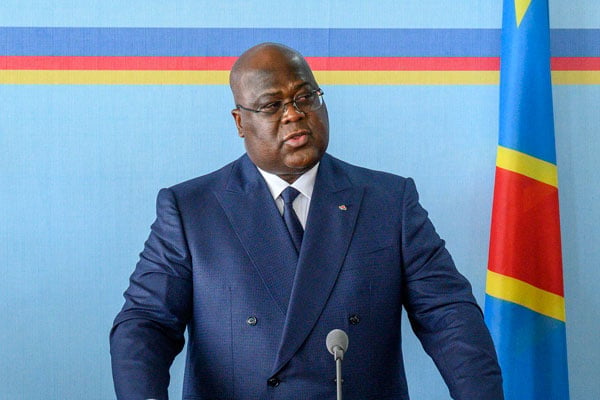Canada offers lessons on LNG project for Tanzania

Shell Exploration and Production Tanzania Ltd managing director Marc den Hartog speaks at a past event. PHOTO | COURTESY
When LNG Canada said it would go forward with a $31-billion energy megaproject in Kitimat, Canadian energy industry was already hoping that it will be the first of many such plants on the country’s Pacific Coast.
The Royal Dutch Shell PLC-led consortium announced the project’s green light early in October and the move was celebrated by the area residents.
Shell, Petronas, PetroChina, Mitusubishi Corporation and Kogas decided to build the liquefied natural gas (LNG) export facility in Kitimat, British Columbia.
Considering that Tanzania which has so far discovered 57 trillion cubic feet (TCF) of natural gas is also pursuing a similar project, BusinessWeek Reporter Rosemary Mirondo interviewed the managing director of Shell Exploration and Production Tanzania Ltd, Mr Marc den Hartog, on what Tanzania could learn from the project. Read on….
QUESTION: The Kitimat project is a big step towards economic development as well as achieving LNG export in Canada. What can you say for Tanzania on a similar project?
ANSWER: You are right to say that this is a huge step forward for Canada. The “Final Investment Decision” is the single most important milestone in any mega-project development, and it means the project is now definitely coming into existence. In fact, construction is already in full speed. Getting to this point was the culmination of seven years of hard and intense collaboration between the investors and the host government (in the case of Canada, this is both the Federal Government and the Provincial Government of the state of British Columbia).
Unfortunately, in Tanzania we are not that far yet. The investors have completed the gas exploration phase successfully and completed all preliminary design work. However, what we do not have yet is the so-called Host Government Agreement, or HGA, which is needed to establish the commercial, fiscal, and regulatory framework to underpin the project. Discussions on this agreement started in October 2016 but still have a considerable way to go.
Recently, it was reported that LNG investment companies had failed to reach a collective decision and therefore the process had been halted in Tanzania. What is the challenge behind this?
No, an LNG project is ever easy! To illustrate that a little, five years ago in Canada there were more than 20 proposed LNG projects. Out of those 20 projects, today most have been officially terminated, and only one – LNG Canada – is actually going ahead. While there is an abundance of gas in Canada, still all of those Canadian projects faced tough challenges: to bring capital costs down to the lowest possible level, to find well-paying market outlets for their LNG, to make good arrangements with the local communities for local content, and most importantly, to work closely with the Canadian government to agree conducive fiscal and other regulatory terms.
Just as in Canada, the investors here in Tanzania face all those challenges, and it is therefore not unusual that there are sometimes differences of opinion on the best way to go forward. This simply means we need to re-double our efforts to jointly come the very best solution for Tanzania. What makes life a little easier here than in Canada, is that there is only enough gas for one LNG project, so rather than compete (as they did in Canada), the investors here simply have no choice but to collaborate.
What is happening; have they been able to reach a common ground? If yes what is happening? If not what is being done to bridge the gap?
The investors submitted a comprehensive joint proposal for HGA terms to the government in March of last year. This has been under discussion since then, with occasional stops and starts.
Do you think Tanzania LNG project is an attractive investment worth pursuing?
Yes, fundamentally, the Tanzania LNG project is a very good project. There is a good quantity of gas, sufficient for both LNG exports and to supply the domestic market. We are particularly lucky that Shell has developed new, state-of-the-art LNG technology for Canada to help lower the investment cost there (this is one of the reasons that LNG Canada project could proceed where so many others projects failed). This same technology can now be utilised in Tanzania, and possibly improved yet further by our development engineers. Tanzania also has some other distinct advantages, like a very good quality construction site in Lindi and a good climate for construction. All in all, provided that we achieve maximum synergy between the holdings of the Tanzania deep water investors, we are confident that we can build the Tanzania project to be highly competitive in the global LNG marketplace.
The importance of competitive construction cost cannot be overestimated. Note only does this make the project more likely to happen, but also the lower the project capital costs, the higher the government share of the project revenue will be as well. This is genuinely a “win-win” for investors and the nation.
Why has it taken too long to reach a decision on the commercial framework unlike the LNG Canada which has made a huge progress?
Even for LNG Canada which in many respects had a ready-made fiscal and regulatory structure, it took seven years of hard work to bring the project to a successful investment decision. In contrast with Canada, sector legislation and the tax regime in Tanzania have undergone a lot of changes in the past decade and they continue to change still. In this context, it is not all that surprising that it is taking quite some time to come to the final investment decision for the Tanzania LNG project.
For investors, it is always better to go faster; after all they have been sinking billion dollars in exploration in Tanzania for eight years already, without even a shilling of revenue. However, a mega project like the Tanzania LNG project can only go as fast as both government and investors are willing and able to go. You know the old African proverb…
What are the lessons that Tanzania can learn from LNG Canada to enable it reach a final investment decision.
There are quite a few good lessons we can pick from Canada. Here are just three:
1. You need the right investors in your project to succeed: companies with the best technology, know-how, financial staying power, plus some sheer hard stamina. Some of projects in Canada that were terminated had sizeable players in it like Chevron and Exxon, yet they did not make it over the line.
2. Only a true partnership between host government and investors can create a successful megaproject. The Canadian government made LNG a priority, and then worked tirelessly with the investors, at senior levels, for year after year.
3. Economies of scale are essential to make a competitive project. The LNG Canada project has a capacity of 14 million tons of LNG per annum. This is little larger than what we are planning for Tanzania, but it is significantly larger than many of the other Canadian projects, which therefore lacked scale. In fact, to achieve the go ahead for LNG Canada, it was essential to combine industry forces. Petronas of Malaysia had been developing a separate project in Canada, but then last year instead decided to join the Shell-led consortium of LNG Canada and it is this combination of forces that got the project to its final investment decision.
Any other comment?
We have recently been asked the question: now that Shell is building LNG Canada, do you still have time for Tanzania? The answer is – of course - yes. We are a large company in LNG, and at any one time we have two or three LNG project under construction somewhere around the world (today, they are: Prelude, Elba Island, and LNG Canada), so this is normal for us. The LNG global market is growing at some 4 per cent per year, and so just to grow along with that market we need to kick off another project every couple of years. Tanzania fits very well in that picture, and moreover all the experience and innovations that arise from projects like the one in Canada will help to make the one in Tanzania even better.




